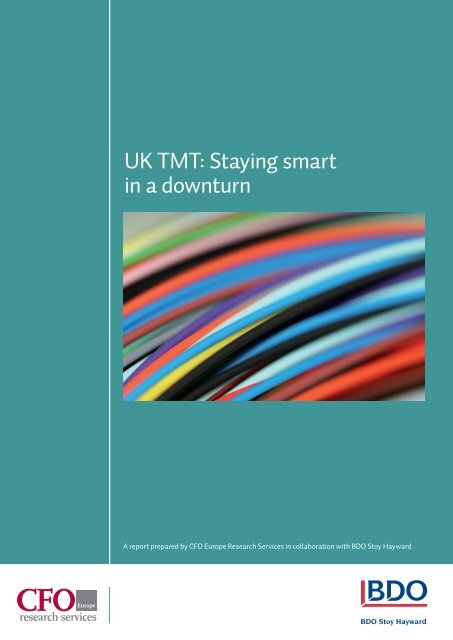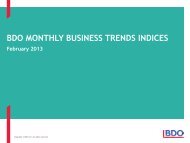UK TMT: Staying smart in a downturn - UK.COM
UK TMT: Staying smart in a downturn - UK.COM
UK TMT: Staying smart in a downturn - UK.COM
Create successful ePaper yourself
Turn your PDF publications into a flip-book with our unique Google optimized e-Paper software.
<strong>UK</strong> <strong>TMT</strong>: <strong>Stay<strong>in</strong>g</strong> <strong>smart</strong><strong>in</strong> a <strong>downturn</strong>A report prepared by CFO Europe Research Services <strong>in</strong> collaboration with BDO Stoy Hayward
<strong>UK</strong> <strong>TMT</strong>: <strong>Stay<strong>in</strong>g</strong> <strong>smart</strong> <strong>in</strong> a <strong>downturn</strong> is published by CFO Europe Research Services, 25 St. James’s Street, London,SW1A 1HG, <strong>UK</strong>. Please direct any enquiries to Emily Williamson on +44 (0)20 7830 7000 or at emilywilliamson@cfoeurope.com. CFO Europe Research Services is part of CFO Publish<strong>in</strong>g Corporation, which produces CFO Europemagaz<strong>in</strong>e and CFO <strong>in</strong> the United States. CFO Publish<strong>in</strong>g is part of The Economist Group.April 2009Copyright © 2009 CFO Publish<strong>in</strong>g Corp., which is solely responsible for its content. All rights reserved. No partof this report may be reproduced, stored <strong>in</strong> a retrieval system, or transmitted <strong>in</strong> any form, by any means, withoutwritten permission.
<strong>UK</strong> <strong>TMT</strong>: <strong>Stay<strong>in</strong>g</strong> <strong>smart</strong><strong>in</strong> a <strong>downturn</strong>A report prepared by CFO Europe Research Services <strong>in</strong> collaboration with BDO Stoy Hayward
2<strong>UK</strong> <strong>TMT</strong>: <strong>Stay<strong>in</strong>g</strong> <strong>smart</strong> <strong>in</strong> a <strong>downturn</strong>ContentsSponsor’s foreword 3About this report 4Executive summary 4From acquisition to <strong>in</strong>novation 6and strategic partner<strong>in</strong>gGrowth, expectations and risks 8Plann<strong>in</strong>g for the future 9Conclusion 11Study methodology 12April 2009© 2009 CFO PUBLISHING CORP.
Sponsor’sforeword3Sponsor’s forewordWe are delighted to share with you the <strong>in</strong>sights fromour latest survey, which exam<strong>in</strong>es the risks andopportunities of the <strong>downturn</strong> for the Technology,Media and Telecoms (<strong>TMT</strong>) sector. It has beenfasc<strong>in</strong>at<strong>in</strong>g to be able to see how the views of the sectorhave changed <strong>in</strong> comparison to this time last year.There is no doubt that the environment is far toughernow than it was a year ago – many more companiesare forecast<strong>in</strong>g a decl<strong>in</strong>e <strong>in</strong> revenues <strong>in</strong> 2009. Butthe situation is not term<strong>in</strong>al – strong growth is stillforecast <strong>in</strong> the medium term.Interest<strong>in</strong>gly, there has been a significant change <strong>in</strong>how <strong>TMT</strong> bus<strong>in</strong>esses plan to grow. We are expect<strong>in</strong>gto see an <strong>in</strong>crease <strong>in</strong> strategic partnerships, withmore bus<strong>in</strong>esses will<strong>in</strong>g to collaborate <strong>in</strong> orderto succeed. Last year, growth was all aboutacquisition, but a year on, <strong>in</strong>novation is the preferredroute, comb<strong>in</strong>ed with stretch<strong>in</strong>g exist<strong>in</strong>g productsand services <strong>in</strong>to new markets.To fuel this <strong>in</strong>novation-led growth, <strong>TMT</strong> bus<strong>in</strong>essesare plann<strong>in</strong>g to ma<strong>in</strong>ta<strong>in</strong> their <strong>in</strong>vestment <strong>in</strong>research and development. However, the numberof <strong>TMT</strong> bus<strong>in</strong>esses that feel they have access tothe fund<strong>in</strong>g they need to operate effectively hasfallen dramatically. As the economic environmentrema<strong>in</strong>s tough over the com<strong>in</strong>g months, thetension between the need to ma<strong>in</strong>ta<strong>in</strong> <strong>in</strong>vestmentand the scarcity of external fund<strong>in</strong>g will become<strong>in</strong>creas<strong>in</strong>gly critical.If this situation cont<strong>in</strong>ues, there is a real risk that<strong>in</strong>vestment <strong>in</strong> research and development, thelifeblood of many <strong>TMT</strong> bus<strong>in</strong>esses, will dry up,stall<strong>in</strong>g <strong>UK</strong> <strong>in</strong>novation.On a positive note, three-year growth projectionsare broadly <strong>in</strong> l<strong>in</strong>e with those set out <strong>in</strong> last year’ssurvey – <strong>TMT</strong> cont<strong>in</strong>ues to benefit from a healthylevel of self-confidence and optimism.I would like to thank all those who gave their timeto provide us with their valuable <strong>in</strong>sight <strong>in</strong>to theirstrategies, ambitions and fears. We hope you enjoythe report.Julian FrostPartner, Head of <strong>TMT</strong>julian.frost@bdo.co.uk+44 (0)20 7893 2350© 2009 CFO PUBLISHING CORP. April 2009
4<strong>UK</strong> <strong>TMT</strong>: <strong>Stay<strong>in</strong>g</strong> <strong>smart</strong> <strong>in</strong> a <strong>downturn</strong>Executive summaryThere is a surpris<strong>in</strong>g amount of optimism <strong>in</strong> theTechnology, Media and Telecoms (<strong>TMT</strong>) sector,<strong>in</strong> spite of the challenges of do<strong>in</strong>g bus<strong>in</strong>ess dur<strong>in</strong>gthe <strong>downturn</strong>. <strong>TMT</strong> companies are try<strong>in</strong>g toprotect themselves aga<strong>in</strong>st <strong>in</strong>evitable threats -fall<strong>in</strong>g customer demand, <strong>in</strong>creas<strong>in</strong>g competitionand shr<strong>in</strong>k<strong>in</strong>g credit availability. In do<strong>in</strong>g so, theyaren’t fixat<strong>in</strong>g on short-term reactive measures,such as sell<strong>in</strong>g assets, outsourc<strong>in</strong>g, or cutt<strong>in</strong>g backon R&D spend<strong>in</strong>g, and they have also turned awayfrom their former <strong>in</strong>cl<strong>in</strong>ation for M&A. Their focusnow is on <strong>in</strong>novation, tapp<strong>in</strong>g <strong>in</strong>to new marketsand strategic partner<strong>in</strong>g. Indeed, the majority ofrespondents are confident of meet<strong>in</strong>g their longertermgrowth targets. Here are the key f<strong>in</strong>d<strong>in</strong>gs:Innovation and strategicpartnerships have replacedacquisition as top growth strategiesInnovation has emerged as the ma<strong>in</strong> growthstrategy among <strong>UK</strong> <strong>TMT</strong> companies. 31% say thisis their top strategy for growth, compared witha mere 5% a year ago. This could also expla<strong>in</strong>why 80% of respondents don’t plan to cut R&Dspend<strong>in</strong>g. The rise of <strong>in</strong>novation as a favouredchoice of growth strategy reflects current marketrealities, <strong>in</strong> which merger and acquisition activityhas been severely curtailed by a lack of fund<strong>in</strong>g.In keep<strong>in</strong>g with this, <strong>UK</strong> <strong>TMT</strong> companies’ appetitefor M&A has lessened considerably s<strong>in</strong>ce ourprevious research. At the same time, strategicpartnerships are look<strong>in</strong>g a lot more likely: 15% ofrespondents cite partnerships as their top threeyeargrowth strategy, compared with just 5% atthe end of 2007. Recent high-profile examplesreflect this trend.Slim growth <strong>in</strong> the next year, but threeyeargrowth targets rema<strong>in</strong> unchangedThe recession is carry<strong>in</strong>g a st<strong>in</strong>g for <strong>TMT</strong>companies, but <strong>in</strong> their view, it’s a short-term one.40% of respondents forecast 0-5% growth <strong>in</strong> the>About this reportIn January 2009, CFO Europe Research Services, a unit of CFOPublish<strong>in</strong>g and part of The Economist Group, began a researchproject with BDO Stoy Hayward, the <strong>UK</strong> member firm of BDOInternational.This report is based on the results of an onl<strong>in</strong>e surveycompleted by 78 <strong>UK</strong>-based senior executives work<strong>in</strong>g <strong>in</strong> theTechnology, Media and Telecommunications (<strong>TMT</strong>) sector. Weasked about companies’ growth strategies, access to capital,and the impact of the economic <strong>downturn</strong>. In this report, wecompare the most recent f<strong>in</strong>d<strong>in</strong>gs with those from a similarsurvey conducted at the end of 2007, the results of whichwere published <strong>in</strong> a report entitled “Deliver<strong>in</strong>g fast-growthstrategies <strong>in</strong> challeng<strong>in</strong>g times” <strong>in</strong> April 2008.CFO Europe Research Services and BDO Stoy Haywarddeveloped the scope of the research jo<strong>in</strong>tly. BDO Stoy Haywardfunded the research and the publication of our f<strong>in</strong>d<strong>in</strong>gs, and wewould like to thank their team for its <strong>in</strong>sight and support. AtCFO Europe Research Services, Emily Williamson managed theproject and wrote the report.<strong>UK</strong> <strong>TMT</strong>: <strong>Stay<strong>in</strong>g</strong> <strong>smart</strong> <strong>in</strong> a <strong>downturn</strong> is published byCFO Europe Research Services, 25 St. James’s Street,London, SW1A 1HG, <strong>UK</strong>. Please direct any enquiriesto Emily Williamson on +44 (0)20 7830 7000 or atemilywilliamson@cfoeurope.com.com<strong>in</strong>g year, while 16% forecast negative growth.The three-year outlook, however, looks morepositive, and is largely <strong>in</strong> l<strong>in</strong>e with the results ofthe December 2007 survey, with around threequartersof respondents forecast<strong>in</strong>g annualrevenue growth of up to 20% <strong>in</strong> the next threeyears, and around a quarter forecast<strong>in</strong>g growth ofover 20%. The confidence <strong>in</strong> longer term growthreflects a belief that <strong>in</strong>novation strategies andR&D spend<strong>in</strong>g will succeed <strong>in</strong> driv<strong>in</strong>g profits <strong>in</strong>2010 and beyond.CFOs are less optimistic abouthitt<strong>in</strong>g their targetsAlthough nearly two-thirds of respondents areconfident that their companies can meet theirrevenue growth targets for the next three years,this is still an 18 percentage po<strong>in</strong>t drop from theApril 2009© 2009 CFO PUBLISHING CORP.
<strong>UK</strong> <strong>TMT</strong>: <strong>Stay<strong>in</strong>g</strong> <strong>smart</strong> <strong>in</strong> a <strong>downturn</strong>581% who said the same at the end of 2007. Thesurvey results suggest that this drop stems fromexternal market woes due to recession, ratherthan matters <strong>in</strong>ternal to the f<strong>in</strong>ance organisation.Indeed, nearly three-quarters of all respondentsare confident that their f<strong>in</strong>ance departmentshave the staff, resources and skills they need tosupport the company’s growth ambitions.The worldwide economy is the mostimportant macro-trend fac<strong>in</strong>g <strong>TMT</strong>companies <strong>in</strong> the next three years32% of respondents cite the worldwide economyas the most important macro-trend fac<strong>in</strong>gtheir companies <strong>in</strong> the next three years. Morespecifically, respondents cite fall<strong>in</strong>g customerdemand, the availability of credit and customersextend<strong>in</strong>g or default<strong>in</strong>g on credit terms – typical<strong>downturn</strong>-type threats – as the ma<strong>in</strong> risks totheir companies’ revenue growth targets. If <strong>TMT</strong>companies were go<strong>in</strong>g to take one-time reactivemeasures <strong>in</strong> response to these threats, mosthave already acted. The numbers of respondentswhose companies are plann<strong>in</strong>g to make cutbacksor restructure are low <strong>in</strong> comparison to thenumbers of those who have either already <strong>in</strong>itiatedsuch changes, or who don’t plan to. Instead,<strong>TMT</strong> companies will look to counter the threatsto growth with proactive strategies – <strong>in</strong>novation,expansion <strong>in</strong>to new market segments and newcountries, as well as strategic partnerships.<strong>TMT</strong> executives f<strong>in</strong>d access<strong>in</strong>g capitalharder now than about a year agoAccess<strong>in</strong>g f<strong>in</strong>ance has become a lot more difficult.38% of respondents are f<strong>in</strong>d<strong>in</strong>g access<strong>in</strong>g capitaleasy, and 31% are f<strong>in</strong>d<strong>in</strong>g it difficult. Thiscompares unfavourably with last year’s survey,when 72% said it was easy to get access to thefund<strong>in</strong>g they need, and only 13% said that itwas difficult. It could also expla<strong>in</strong> why somerespondents appear to have already amassed thefunds they need to see them through the worst –a quarter have no plans to raise any more capital<strong>in</strong> the next three years, compared with 10% whosaid the same <strong>in</strong> the 2007 survey.© 2009 CFO PUBLISHING CORP. April 2009
6<strong>UK</strong> <strong>TMT</strong>: <strong>Stay<strong>in</strong>g</strong> <strong>smart</strong> <strong>in</strong> a <strong>downturn</strong>From acquisition to <strong>in</strong>novationand strategic partner<strong>in</strong>gAt the end of 2007, <strong>TMT</strong> companies were bank<strong>in</strong>gon acquisition to fulfil their growth plans, with60% of respondents report<strong>in</strong>g that acquisitionwas their number one growth strategy dur<strong>in</strong>g thenext three years. Now, this appetite for M&A islimited, with only 12% of respondents say<strong>in</strong>g theircompanies are plann<strong>in</strong>g acquisition as a long-termgrowth strategy. (See chart 1.)No doubt the current recession has made rais<strong>in</strong>gcredit for M&A an unrealistic prospect. As onemedia sector respondent to the recent surveypo<strong>in</strong>ted out, “there is extreme difficulty <strong>in</strong>execut<strong>in</strong>g M&A, other than through private mergers,[which] will reduce growth opportunities.”Certa<strong>in</strong>ly, consolidation has become much less ofa driv<strong>in</strong>g force <strong>in</strong> the <strong>in</strong>dustry. In the 2007 survey,nearly two-thirds of respondents cited sectorconsolidation as the most important macro-trend> Chart 1 – Top three-year growth strategies: 2007 versus 2009Acquisition2007 200912%60%fac<strong>in</strong>g their company <strong>in</strong> the next three years; only6% say the same about <strong>in</strong>dustry consolidation<strong>in</strong> the latest survey. All eyes are now focused onthe perilous state of the global economy, whichis seen to be the most important macro-trendfac<strong>in</strong>g companies <strong>in</strong> the next three years, followedby competition <strong>in</strong> domestic markets, <strong>in</strong>dustryconsolidation and technological advances. (Seechart 2.)With M&A look<strong>in</strong>g unlikely aga<strong>in</strong>st the backdropof recession and with competition <strong>in</strong>tensify<strong>in</strong>g,how are <strong>TMT</strong> companies look<strong>in</strong>g to grow? Well,31% of respondents say that <strong>in</strong>novation is theircompanies’ top growth strategy; a result thatstands <strong>in</strong> stark contrast to 5% who said thesame <strong>in</strong> the 2007 survey. Rapid <strong>in</strong>novation hasalways been a viable option for the <strong>TMT</strong> <strong>in</strong>dustryand, of late, one of its sh<strong>in</strong><strong>in</strong>g stars has beenthe development of affordable mobile wireless<strong>in</strong>ternet that is available via PCs. The developmentof wireless <strong>in</strong>ternet is also responsible for therapid evolution of the Smartphone: the launch ofthe application-heavy iPhone and the BlackberryBold, for example, means that Smartphones areno longer the reserve of the bus<strong>in</strong>essman andare quickly becom<strong>in</strong>g a consumer commodity.Accord<strong>in</strong>g to Oliver Wyman’s 2009 “State of theIndustry” report for the communications, mediaand technology sectors, shipments of Smartphonesgrew from 16m <strong>in</strong> 2004 to 120m <strong>in</strong> 2008.InnovationNew markets <strong>in</strong>exist<strong>in</strong>g countriesNew markets <strong>in</strong>new countriesNew productsOrganic growthStrategic partnerships2%5%6%5%4%5%7%9%16%14%15%31%0% 10% 20% 30% 40%50% 60% 70%Another notable difference between the 2009and 2007 surveys is a stronger lean<strong>in</strong>g towardsstrategic partnerships. 15% of respondents citethis as their top growth strategy for the nextthree years, compared with 5% at the end of 2007.(See chart 1.) When capital is <strong>in</strong> short supply,collaborat<strong>in</strong>g and shar<strong>in</strong>g assets with rivals andequals alike is a good battle tactic, and there havebeen some recent high-profile examples of this.In March this year, for <strong>in</strong>stance, former arch rivalmobile phone network providers Vodafone andTelefónica, the owner of O2, announced a plan toshare their network <strong>in</strong>frastructure <strong>in</strong> Germany,Spa<strong>in</strong>, Ireland and the <strong>UK</strong> to generate hundredsof millions of pounds <strong>in</strong> cost sav<strong>in</strong>gs over the nextApril 2009© 2009 CFO PUBLISHING CORP.
<strong>UK</strong> <strong>TMT</strong>: <strong>Stay<strong>in</strong>g</strong> <strong>smart</strong> <strong>in</strong> a <strong>downturn</strong>7ten years. The companies will still compete forcustomers whom they will cont<strong>in</strong>ue to manage<strong>in</strong>dependently; nevertheless, partnership on such agrand scale would have seemed highly improbablebefore the economic <strong>downturn</strong>.Partnerships between non-rivals are a sensiblemove for tak<strong>in</strong>g on the might of the competition,which is the second important macro-trend fac<strong>in</strong>g<strong>UK</strong> <strong>TMT</strong> companies <strong>in</strong> the next three years. InFebruary this year, for example, Google andVodafone teamed up to challenge the dom<strong>in</strong>anceof Apple’s iPhone <strong>in</strong> the European Smartphonemarket with the launch of HTC Magic. The Magichandset, which features a touch-screen, camera,GPS and Wi-Fi, was developed by the TaiwaneseHTC Corporation. It uses Google’s Androidoperat<strong>in</strong>g system and will be exclusively availableon the Vodafone network.<strong>TMT</strong> companies will also look to tap <strong>in</strong>to newmarket segments as well as new countries. (Seechart 3.) For those plann<strong>in</strong>g to grow the bus<strong>in</strong>essby enter<strong>in</strong>g new markets <strong>in</strong> new countries, WesternEurope is the most popular choice. This makessense <strong>in</strong> light of the fact that more respondentssee competition com<strong>in</strong>g from home rather thanemerg<strong>in</strong>g markets. (See chart 2.) New marketsand new countries were ranked second and third<strong>in</strong> a list of preferred growth strategies <strong>in</strong> the 2007survey, but whereas that seemed likely to happenvia mergers and acquisitions, this time, <strong>TMT</strong>companies are bank<strong>in</strong>g on <strong>in</strong>novative productsand strategic tie-ups.> Chart 2 – Macro-trends 2009Worldwide economyCompetitors fromhome marketsTechnological advancesIndustry consolidationExpansionCompetitors fromemerg<strong>in</strong>g marketsEnvironmental issuesRegulation 3% 1% 11%> Chart 3 – Three-year growth strategies 2009InnovationNew market segments <strong>in</strong>exist<strong>in</strong>g countries of operationStrategic partnershipsExist<strong>in</strong>g market segments<strong>in</strong> new countriesOrganic growthNew productsAcquisitionNew market segments <strong>in</strong>new countriesOur company is not expect<strong>in</strong>gto grow <strong>in</strong> the next three years0% 10% 20% 30% 40% 50% 60% 70%6% 21%20%15% 8%16%9% 22%10%14% 13% 11%12% 8% 6%4% 7% 6%31% 13%17%9% 9% 13%1%32% 19%14%19% 23%14%10% 16%14%6% 12%21%5% 15%14%14% 8% 5%10% 4% 6%> Chart 4 – Revenue growth targets 2009Negative growth0-5%6-10%Rank<strong>in</strong>g 1Rank<strong>in</strong>g 2Rank<strong>in</strong>g 3Rank<strong>in</strong>g 1Rank<strong>in</strong>g 2Rank<strong>in</strong>g 30% 10% 20% 30% 40% 50% 60% 70%16%13%18%22%40%11-15%5%15%16-20%8%16%21-30%31-40%41-50%6%4%3%3%4%In the next yearIn the next three years50%+5%22%0% 10% 20% 30% 40%50% 60%© 2009 CFO PUBLISHING CORP. April 2009
8 <strong>UK</strong> <strong>TMT</strong>: <strong>Stay<strong>in</strong>g</strong> <strong>smart</strong> <strong>in</strong> a <strong>downturn</strong>Growth, expectations and risksMost companies’ revenue expectations for the yearahead are modest at best. The majority of respondentsforecast 0-5% growth <strong>in</strong> the next year, whileanother 16% forecast negative growth. (See chart 4.)Expectations for revenue growth over the nextthree years are more mixed, with 22% forecast<strong>in</strong>gslim growth of 0-5% and another 22% forecast<strong>in</strong>gmassive growth of 50% and over. Respondents’comments reflect this view of mixed fortunes ahead,with some about to seize on new opportunities andothers seem<strong>in</strong>g bogged down <strong>in</strong> difficulties. Forexample, one f<strong>in</strong>ance executive <strong>in</strong> the technologysector says that the trad<strong>in</strong>g environment is “tougherthan I can ever recall,” add<strong>in</strong>g that “2009 will bemake or break for a lot of companies <strong>in</strong> our sector.”Another respondent reports that “the opportunitiesare fewer but still very good, provided… the projectf<strong>in</strong>ances [can be found].” And the f<strong>in</strong>ance chief ofone software company said the current marketconditions “provide diverse opportunities that wedid not experience before.”Meanwhile, <strong>in</strong> telecoms, one respondent claims thatthere is still sufficient customer demand despite the<strong>downturn</strong>, while another counters that customersare now “cautious about <strong>in</strong>vest<strong>in</strong>g <strong>in</strong> long-termprojects,” mak<strong>in</strong>g “forecast<strong>in</strong>g and plann<strong>in</strong>g very> Chart 5 – Risks to revenue growth targets 2009Fall<strong>in</strong>g customer demandAvailability of creditCustomers extend<strong>in</strong>g creditterms/default<strong>in</strong>gCompetitor consolidationNew market entrantsTalent retentionSuppliers rais<strong>in</strong>g pricesCost of borrow<strong>in</strong>gVolatile commodity prices31% 26%7%26% 10% 12%8% 25%8%3% 10% 15%4% 18%5% 7% 7%23% 9% 8%4% 7%20%1% 7%Rank<strong>in</strong>g 1Rank<strong>in</strong>g 2Rank<strong>in</strong>g 30% 10% 20% 30% 40% 50% 60% 70%difficult.” The mixed messages cont<strong>in</strong>ue <strong>in</strong> the mediasector, where some respondents compla<strong>in</strong> that newclient w<strong>in</strong>s are tak<strong>in</strong>g longer to sign off, while otherssee a golden opportunity to take customers fromfail<strong>in</strong>g competitors.A broader view of the three-year growth targetprojections show them to be <strong>in</strong> l<strong>in</strong>e with those ofthe 2007 survey. Around three-quarters of 2007and 2009 respondents forecast annual revenuegrowth of 0-20% <strong>in</strong> the next three years, andaround a quarter forecast growth of 21-50%. Thedegree to which respondents feel that the creditcrunch has harmed their companies’ abilities tofulfil strategies for growth has similarly stayed thesame - 64% this year versus 68% at the end of2007. However, the worldwide economy now ranksas the most important macro-trend fac<strong>in</strong>g <strong>TMT</strong>companies <strong>in</strong> the next three years, and <strong>in</strong> keep<strong>in</strong>gwith this, respondents report that the top risksto their companies’ revenue growth targets arefall<strong>in</strong>g customer demand, availability of credit andcustomers default<strong>in</strong>g on credit terms. (See chart 5.)The bleak economic situation and its repercussionsfor do<strong>in</strong>g bus<strong>in</strong>ess have made the idea of an exitstrategy less likely – for the next 1-2 years at least.Only 6% of respondents say that an exit strategyis part of their bus<strong>in</strong>ess plans <strong>in</strong> the next 1-2 years,compared with 20% who said the same <strong>in</strong> the 2007survey.Are <strong>TMT</strong> CFOs feel<strong>in</strong>g confident of their ability to fulfiltheir growth expectations <strong>in</strong> spite of the challengesthey are fac<strong>in</strong>g? The levels of confidence <strong>in</strong> revenuegeneration have certa<strong>in</strong>ly dropped s<strong>in</strong>ce the endof 2007, but, <strong>in</strong> view of the severity of the crisis, arestill fairly high: 63% of those surveyed <strong>in</strong> 2009 areconfident that their companies can meet their revenuegrowth targets for the next three years, a 20 percentagepo<strong>in</strong>t drop from the 81% who said the same <strong>in</strong>the 2007 survey. Internally, however, CFOs are asconfident as ever. Nearly three-quarters of them areconfident that their f<strong>in</strong>ance department has the staff,resources and skills needed to support the company’sgrowth ambitions – 71% compared with 78% <strong>in</strong> 2007.April 2009© 2009 CFO PUBLISHING CORP.
<strong>UK</strong> <strong>TMT</strong>: <strong>Stay<strong>in</strong>g</strong> <strong>smart</strong> <strong>in</strong> a <strong>downturn</strong>9Plann<strong>in</strong>g for the futureUnsurpris<strong>in</strong>gly, <strong>TMT</strong> companies are f<strong>in</strong>d<strong>in</strong>g it muchharder to raise capital now than they were at theend of 2007, and just over a quarter of respondentscite the availability of credit as one of the top risksto their companies’ growth strategies. (See chart5.) While 38% of respondents say that it is prov<strong>in</strong>geasy to get the fund<strong>in</strong>g that they need to operateeffectively, 31% say they are f<strong>in</strong>d<strong>in</strong>g it difficult.This compares unfavourably with 2007’s survey,when 72% said that it was easy to get access to thefund<strong>in</strong>g they needed, and only 13% said that it wasdifficult. (See chart 6.)Respondents at companies that are f<strong>in</strong>d<strong>in</strong>g itdifficult to access funds at the moment report thatthere is “virtually no availability of equity f<strong>in</strong>anc<strong>in</strong>g,”while debt is “only available at prohibitive cost[and] on unrealistic terms.” Others say thatalternative sources of private fund<strong>in</strong>g are alsodry<strong>in</strong>g up: “[Venture capital] fund<strong>in</strong>g has droppedoff significantly”, and “Valuations render fund<strong>in</strong>gextremely expensive, with high risk of large dilutionand loss of control.”on an ongo<strong>in</strong>g basis and at acceptable cost,” saysa respondent who describes their company asasset-rich. “We are cash generative so we can turnoff CapEx and pay down debt comfortably, but thislimits potential for growth.”> Chart 6 – Ease of access<strong>in</strong>g fund<strong>in</strong>g: 2007 versus 2009Very easyEasyNeither easy nor difficultDifficultVery difficult2%11%15%17%16%15%2007 200921%22%32%0% 10% 20% 30% 40%> Chart 7 – Three-year plans for rais<strong>in</strong>g capital: 2007 versus 200950%50% 60% 70%It is clear that the capital markets have all but driedup: only 1% of respondents plan to try the marketsfor capital <strong>in</strong> the next three years, compared with18% at the end of 2007. Investment banks areanother closed avenue, with 1% plann<strong>in</strong>g to takethis route, compared with 21% of respondents <strong>in</strong> ourprevious survey. (See chart 7.)Bank loansCapital from<strong>in</strong>vestment banksPrivate equity1%2007 20099%17%21%20%12%However, it seems that some companies arealready prepared for the shortage of capital, andhave amassed the fund<strong>in</strong>g they need to see themthrough the worst. A quarter of respondentssay that their companies have no plans to raiseadditional capital <strong>in</strong> the next three years,compared with 10% who said the same at theend of 2007. Another 30% plan only to free upcapital from with<strong>in</strong> the bus<strong>in</strong>ess itself (comparedwith just 9% last time) although even this is notideal for some: “We require access to bank debtCapital marketsExist<strong>in</strong>g shareholdersFrom the bus<strong>in</strong>ess itselfNo plans to raiseadditional capital1%9%10%13%15%18%0% 5% 10% 15% 20%25%30%25% 30% 35%© 2009 CFO PUBLISHING CORP. April 2009
10<strong>UK</strong> <strong>TMT</strong>: <strong>Stay<strong>in</strong>g</strong> <strong>smart</strong> <strong>in</strong> a <strong>downturn</strong>This sense of hav<strong>in</strong>g taken action already isreflected <strong>in</strong> the fact that most of the companiesplann<strong>in</strong>g to take one-time reactive measures <strong>in</strong>response to the <strong>downturn</strong> have already done so.The numbers of respondents whose companiesplan to cut budgets or restructure are lowcompared with the numbers of those who haveeither already <strong>in</strong>itiated such changes or who saythey don’t plan to. Of the seven reactive measureslisted, most companies have only taken two: 46%have reviewed their contracts or suppliers, and55% have implemented a staff restructur<strong>in</strong>g. Othermoves are far less common – only 10% have soldassets or plan to do so, while cutbacks <strong>in</strong> R&D andnew outsourc<strong>in</strong>g strategies are also rare. Clearlycompanies aren’t th<strong>in</strong>k<strong>in</strong>g <strong>in</strong> terms of short-termfixes – R&D <strong>in</strong> particular will be an especiallyimportant activity <strong>in</strong> which to <strong>in</strong>vest if companiesare rely<strong>in</strong>g on <strong>in</strong>novation to see them through thetough economic times. (See chart 8.)> Chart 8 – Downturn strategies 2009Have takenPlan to takeDon’t plan to takeStaff restructur<strong>in</strong>g55% 17%28%Review of contracts/suppliers46% 33%22%Cutbacks <strong>in</strong> market<strong>in</strong>g35% 17%48%Outsourc<strong>in</strong>g/offshor<strong>in</strong>g23% 17%60%Office relocation22% 22%56%Cutbacks <strong>in</strong> R&DAssets sale13% 7%80%5% 5%90%0% 10% 20% 30% 40% 50% 60% 70%80% 90% 100%April 2009© 2009 CFO PUBLISHING CORP.
<strong>UK</strong> <strong>TMT</strong>: <strong>Stay<strong>in</strong>g</strong> <strong>smart</strong> <strong>in</strong> a <strong>downturn</strong>11ConclusionThere is no doubt that the state of the worldwideeconomy is mak<strong>in</strong>g life more challeng<strong>in</strong>g for <strong>TMT</strong>companies. Access to cash has become moredifficult, M&A is no longer the preferred path togrowth, and many CFOs expect a fall-off <strong>in</strong> theconsumer market.In this light, <strong>in</strong>novation is look<strong>in</strong>g like the surestway to secure future growth. Innovation hasled to <strong>in</strong>dustry-wide expansion <strong>in</strong> the past, andcompanies are clearly hop<strong>in</strong>g that it will spellsuccess once aga<strong>in</strong>. For this reason, the majorityof surveyed <strong>TMT</strong> companies are wisely not cutt<strong>in</strong>gback on their R&D spend<strong>in</strong>g.As the turmoil <strong>in</strong> the world economy subsides, andwith <strong>in</strong>novation as their primary avenue of growth,<strong>TMT</strong> companies can expect a fiercely competitivemarket place, with a def<strong>in</strong>ed batch of w<strong>in</strong>nersand losers. This is where strategic partnershipswill really be of benefit, with asset shar<strong>in</strong>g andproduct synergies lead<strong>in</strong>g to cost sav<strong>in</strong>gs as wellas revenue growth, and the survey results show atrend start<strong>in</strong>g to emerge here. As the say<strong>in</strong>g goes,if you can’t beat ‘em, jo<strong>in</strong> ‘em.Despite a knock to their optimism, most seniorf<strong>in</strong>ance professionals are still confident about be<strong>in</strong>gable to meet their companies’ long-term revenuegrowth targets, and many see the opportunities aswell as threats thrown up by the economic crisis.On the whole, the three-year outlook for <strong>TMT</strong> companieslooks fairly robust. As one respondent sumsup, “<strong>TMT</strong> has been damaged, but not term<strong>in</strong>ally.”© 2009 CFO PUBLISHING CORP. April 2009
12<strong>UK</strong> <strong>TMT</strong>: <strong>Stay<strong>in</strong>g</strong> <strong>smart</strong> <strong>in</strong> a <strong>downturn</strong>> Job title17%11%Chairman, CEO, Presidentor Manag<strong>in</strong>g DirectorCFO/FDEVP or SVP f<strong>in</strong>anceControllerVP of f<strong>in</strong>anceStudy methodologyIn January 2009, CFO Europe Research Servicesconducted a survey of 78 senior executives <strong>in</strong> the<strong>UK</strong> <strong>in</strong> <strong>TMT</strong> companies. Here is a breakdown of thedemographics:13%3%31%Director of f<strong>in</strong>anceTreasurerOther> Sector25%16%15%41%> LocationGreater London5%1%3%1%Southeast England otherthan Greater LondonSouthwest England28%Northern England14%WalesScotland48%Northern IrelandNot located <strong>in</strong> the <strong>UK</strong>TechnologyMediaTelecommunicationsOther27%> Number of employees> Annual revenues8%3%7%7%4%41%Under £10 million£11-50 million£51-100 million£101-250 million£251-500 million£500 million – £1B£1B-5B£5B-10B£10B+9%13%8%1%8%15%26%21%11%19%Less than 25100-249500-9995000-999925-99250-4991000-499910000 or moreApril 2009© 2009 CFO PUBLISHING CORP.
© 2009 CFO PUBLISHING CORP. April 2009
CFO Europe Research Services:CFO Europe Research Services is a sponsored research group with<strong>in</strong> CFO Publish<strong>in</strong>g Corporation, whichproduces CFO Europe magaz<strong>in</strong>e, and CFO <strong>in</strong> the United States. CFO Publish<strong>in</strong>g is part of The Economist Group.www.cfo.com/europeBDO Stoy HaywardBDO Stoy Hayward LLP operates across the <strong>UK</strong> with over 3,000 partners and staff. BDO Stoy Hayward LLPis a <strong>UK</strong> limited liability partnership and the <strong>UK</strong> Member Firm of BDO International. BDO International isa worldwide network of public account<strong>in</strong>g firms, called BDO Member Firms, serv<strong>in</strong>g <strong>in</strong>ternational clients.Each BDO Member Firm is an <strong>in</strong>dependent legal entity <strong>in</strong> its own country. The Belfast Firm is operated by aseparate partnership.











